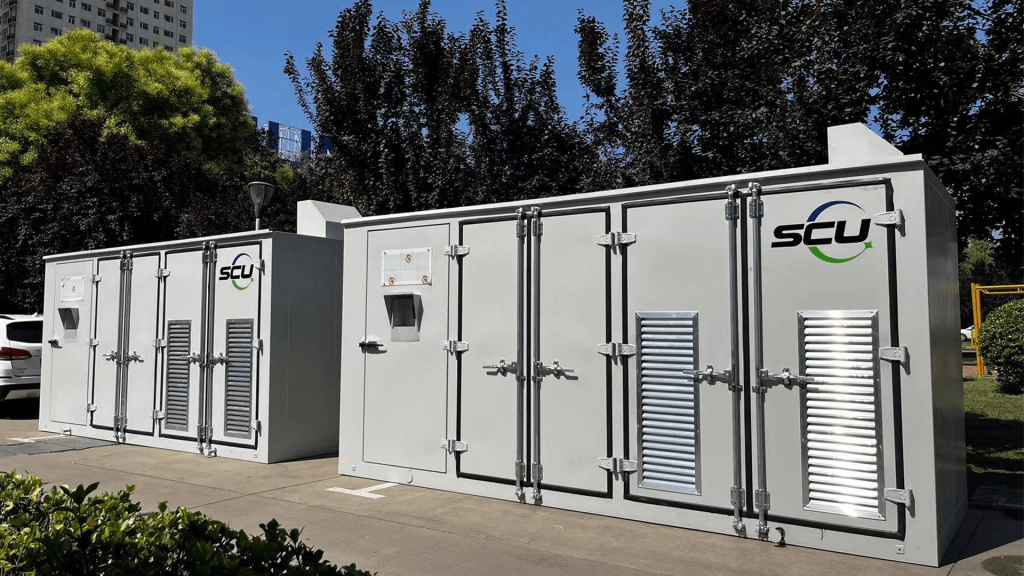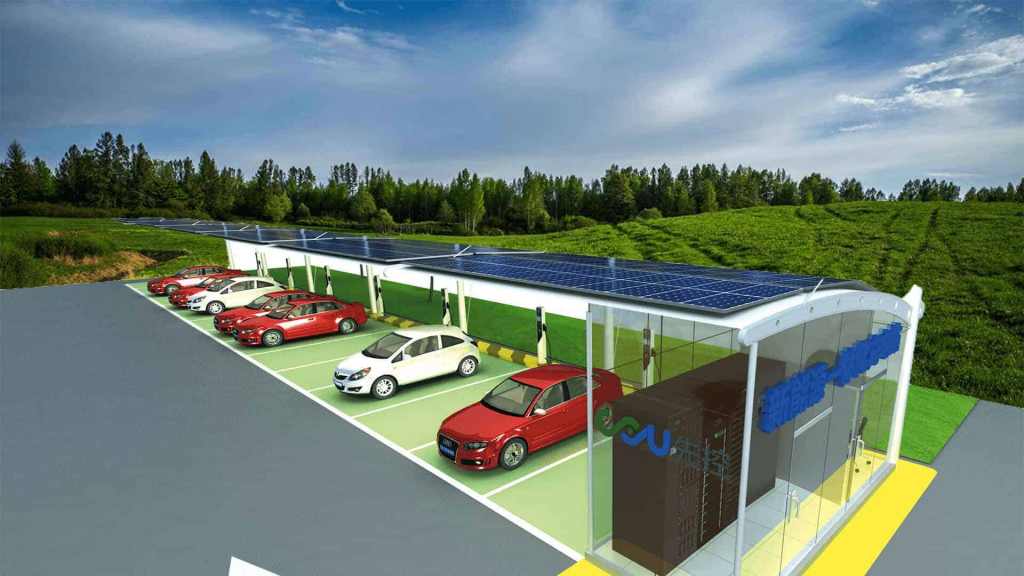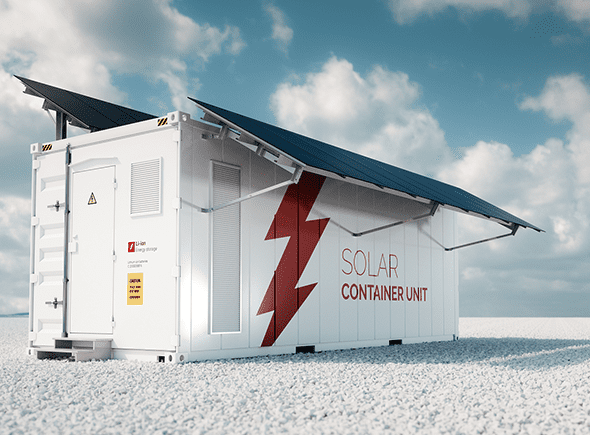Electrochemical energy storage system is a type of energy storage that has developed rapidly in recent years. At this stage, there are several mainstream technical routes for battery energy storage system solutions, and different technical routes have their advantages and disadvantages.
The following is an introduction to the technical routes of these five energy storage solutions:
1. Centralized type: battery cluster → DC cable → DC combiner box → DC cable → centralized converter → AC cable → step-up transformer
Multiple battery clusters of centralized energy storage are directly connected in parallel on the busbar on the DC side. The DC power is merged and converted into AC through a power conversion system. This method is currently a widely used technical route. Its core feature is to centrally deploy large-scale energy storage equipment in one location, usually at or near the center of the power system. These systems are designed to provide multiple power services to increase the reliability, stability and efficiency of the power network. The advantage is that the control is simple, but the disadvantage is that circulating currents will occur when the voltages between battery clusters are inconsistent.
Features:
- Large-Scale Capacity: Centralized energy storage systems typically have large-scale electrical energy capacity and are capable of storing large amounts of electrical energy for future use. This makes them suitable for balancing power systems, handling peak loads, and providing backup power.
- High Power Output: These systems can output electrical energy at high power to meet rapid demand changes in the power system, such as power supply during peak load periods.
- Grid Support: Centralized energy storage can be used to improve grid stability, including frequency and voltage regulation, to cope with fluctuations in the power system.
- Renewable Energy Integration: They can be used to store and smooth the volatile production of renewable energy sources such as solar and wind in order to efficiently inject renewable energy into the power system.
- Emergency Backup Power: Centralized energy storage systems can provide emergency backup power during power outages or power system failures to ensure the continued operation of critical facilities and services.
- Market participation: These systems can participate in the power market and sell energy storage power according to market demand to achieve economic benefits.
Application areas:
- Power System Balancing: Centralized energy storage can be used to balance supply and demand in the power system, helping to maintain voltage and frequency stability. They can respond quickly to system demands and reduce power supply problems during peak load periods.
- Renewable Energy Integration: These systems help resolve renewable energy discontinuities by storing excess renewable electricity and then releasing it into the electricity network when needed.
- Power Market: Centralized energy storage systems can purchase and sell power according to market conditions to achieve arbitrage in the power market and reduce energy costs.
- Emergency Backup Power: During emergencies such as natural disasters or power outages, these systems can provide emergency backup power for critical facilities and social services.
- Battery Energy Storage Power Station: Some centralized energy storage systems constitute battery energy storage power stations, which can provide large-scale power supply as needed.
Overall, centralized energy storage systems play a key role in the sustainability and reliability of power systems, helping to achieve clean energy and energy storage goals. Typically deployed at a large scale, they can effectively respond to changes in electricity demand and support the integration of renewable energy sources.

2. Distributed type: battery cluster → DC cable → converter → AC cable → AC combiner box → AC cable → step-up transformer
Decentralized energy storage is a method of electrical energy storage that, unlike traditional centralized energy storage systems, distributes small energy storage devices across multiple locations, often closer to the point of energy use. Each battery cluster is individually connected in series with a power conversion system, and multiple power conversion systems are connected in parallel on the AC bus side but not on the DC side. The advantage of this method is that it can solve the circulation problem between battery clusters, and each cluster can be managed independently or fault-isolated. The disadvantage is that the large number of converters requires high stability and reliability of the system.
Features:
- The wide spread of locations: Decentralized energy storage systems distribute energy storage units across multiple locations, which can include energy production points such as homes, commercial buildings, industrial facilities, solar panels, and wind turbines.
- Small Scale: Each decentralized energy storage unit is usually small in scale, can be customized according to needs, and is suitable for different sizes and types of electricity loads.
- Load Balancing: Decentralized energy storage can be used to balance power loads, storing power when needed and then releasing it during times of high load to reduce power demand and electricity costs.
- Renewable Energy Support: They help make renewable energy systems more self-sustaining, for example, by storing excess electricity generated by solar panels or wind turbines for use at night or when winds are low.
- Emergency Backup Power: Decentralized energy storage systems can serve as emergency backup power to provide a reliable power supply in the event of a power outage or disaster.
- Power Quality Improvement: They can help improve power quality, including reducing voltage fluctuations and providing instantaneous power support.
Application areas:
- Home Energy Storage: Home decentralized energy storage systems typically include home batteries used to store electricity from solar or smart grid systems. These systems can help households lower their electricity bills, increase their self-sufficiency, and provide backup power during power outages.
- Commercial and Industrial Energy Storage: Commercial and industrial buildings can use Decentralized energy storage systems to balance loads, improve energy efficiency, and reduce electricity costs. They can also support electricity demand response and electricity market participation.
- Microgrids: Microgrids are a typical application of decentralized energy storage. They combine renewable energy, energy storage, and traditional power networks to provide a sustainable and autonomous power supply.
- Electric Vehicle Charging: Decentralized energy storage can be used at electric vehicle charging stations to smooth charging demand, reduce grid load, and reduce peak demand during charging periods.
- Renewable Energy Projects: In renewable energy projects, decentralized energy storage systems can help improve renewable energy’s stability, predictability and power generation efficiency.
The development of decentralized energy storage systems has promoted the popularity and availability of energy storage technology, helping to achieve wider application of clean energy and reducing the load on the power network and carbon emissions. They are generally easier to deploy, suitable for energy needs of all sizes, and have stronger decentralization characteristics.
3. Decentralized type: battery cluster → DC/DC → DC cable → single converter → AC cable → AC combiner box → AC cable → step-up transformer
Distributed energy storage involves distributing multiple distributed energy storage systems or energy storage devices at different locations in the power system to provide broader support and services to the power network. This is different from centralized energy storage (large energy storage devices are concentrated in a central location) and decentralized energy storage (small energy storage devices are distributed in multiple locations). Each battery cluster of distributed energy storage is converted into a consistent voltage through a direct current transformer (DC/DC) and then connected in parallel on the DC side.
The DC power is merged and converted into AC through the power conversion system. Different from the centralized type, the distributed type uses DC/DC in each battery cluster. The advantage is that it can solve the problem of circulating current due to different voltages between battery clusters. The disadvantage is that DC/DC components are added, and there is energy loss.
Features:
- Multi-point Distribution: Distributed energy storage systems deploy energy storage equipment at multiple locations in the power system. These locations can include homes, commercial buildings, industrial areas, power substations, etc.
- Various Applications: These distributed energy storage systems can be used for a variety of different power applications, including power balancing, power quality improvement, peak shaving, emergency backup power, and renewable energy integration.
- Grid Support: Distributed energy storage systems can help power systems maintain stability, including voltage and frequency regulation, to cope with fluctuations in the power system.
- Participation in the Power Market: Some distributed energy storage systems can participate in the power market and sell energy storage power according to market demand to achieve economic benefits.
- Elasticity and Scalability: Distributed energy storage systems usually have high elasticity and scalability, and energy storage devices can be added or removed at any time as needed.
Application areas:
- Microgrids: Distributed energy storage systems are widely used in microgrids to help manage and optimize the energy supply of microgrids. They can improve the reliability, stability, and sustainability of microgrids.
- Urban and Industrial Areas: These systems can be deployed in urban and industrial areas to support power demand management, peak shaving, and power quality improvement.
- Commercial and Industrial Buildings: Distributed energy storage systems can be used in commercial and industrial buildings to help reduce electricity costs, balance power loads, and improve energy efficiency.
- Renewable Energy Projects: In renewable energy projects, distributed energy storage systems can help improve the stability and predictability of renewable energy and improve power generation efficiency.
- Electric Vehicle Charging: Distributed energy storage can be used at electric vehicle charging stations to smooth charging demand, reduce grid load, and reduce peak demand during charging periods.
The use of distributed energy storage systems helps achieve better management and optimization of the power system and improves the reliability, stability, and efficiency of the power system. These systems are suitable for all sizes of energy needs and can be customized for different applications and environmental needs. At the same time, they help promote the wider application of clean energy and reduce the load on the power network and carbon emissions.
4. String type: battery cluster → DC/DC → DC cable → multiple converters → AC cable → AC combiner box → AC cable → step-up transformer
String energy storage is a special type of decentralized power energy storage system. It is usually used in combination with photovoltaic power generation systems (solar battery systems) to improve the efficiency of solar power generation and the proportion of self-consumption. Similar to the distributed type, the difference is that the DC power is converted into AC through multiple smaller-capacity converters instead of being converted through one larger-capacity converter. The advantage is that a single converter failure will not affect the entire energy storage system.
Features:
- Integration with Solar Photovoltaic Systems: String energy storage systems are often directly connected to solar photovoltaic arrays to capture the electricity generated by the photovoltaic system. This enables the system to store solar power generation in real time and release the power when needed.
- Modular Design: String energy storage usually adopts a modular design and consists of multiple small batteries. Each module can operate independently, allowing for more flexible expansion and maintenance.
- Suitable for different scales: These systems are suitable for solar photovoltaic systems of all sizes, from household rooftop photovoltaic systems to large-scale solar power plants at commercial and industrial levels.
- Charging and Discharging Control: The string energy storage system has advanced charging and discharging control functions, which can automatically control the flow of electric energy at different time periods to maximize self-use rate.
- Power Smoothing and Peak Shaving: These systems can help smooth the load curve of the power system, reduce peak loads, and reduce peak demand in the electricity market.
Application areas:
- Home Solar Power Station: String energy storage systems can be used in conjunction with home solar power stations to store excess solar power for use at night or in cloudy weather. This helps households lower their electricity bills, increase self-sufficiency, and provide emergency backup power.
- Commercial and Industrial Solar Energy Storage Project: In commercial and industrial buildings, string energy storage systems can be used in conjunction with large-scale solar plants to help smooth electrical loads, reduce peak demand, and improve energy efficiency.
- Participation in the Power Market: Some string energy storage systems can participate in the power market and purchase and sell electric energy according to market demand to achieve economic benefits.
- Microgrid: In a microgrid, string energy storage systems can be used to manage and optimize the energy supply of the microgrid, improving reliability and sustainability.
- Rural Electrification Projects: In remote or rural areas, string energy storage systems can provide stable power supply and improve energy availability.
The use of string energy storage systems can help increase the proportion of solar power generation for self-use, reduce dependence on traditional power networks, reduce electricity bills, and promote the wider application of clean energy. These systems are generally easy to install and manage and can be customized for different uses and sizes.
5. High-voltage cascade direct-mounted type: battery → H bridge (DC/AC power unit) → H bridge cascade → three-phase star connection
High-voltage cascaded Direct Rack Energy Storage contains multiple energy storage units. Each energy storage unit comprises an H-bridge and an independent small battery stack. Each phase consists of multiple energy storage units connected in series to a certain voltage and directly connected to the AC grid. It uses a series of high-voltage battery components arranged in a cascade and connected directly to the power system to provide various power services and functions.
The advantage is that there is no need for a step-up transformer, which reduces system losses and floor space. There is no parallel connection between battery clusters, and the problem of inter-cluster circulation is eliminated. The disadvantage is that it is only economical above 5MW and can only output voltage levels such as 6kV and 10kV, which lacks flexibility in industrial and commercial applications.


